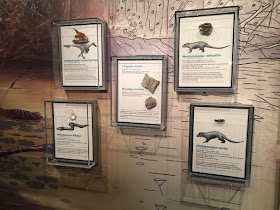As the title suggests, The Last American Dinosaurs showcases the creatures that lived at the very end of the Cretaceous period, called the Maastrichtian era, between 68 and 66 million years ago, from what is now Western North America. This area is referred to as the Hell Creek formation. These were the dinosaurs that suffered as a result of the famous meteorite hitting the earth, causing the extinction of the dinosaurs...but not really because birds are still alive. A lot of the most famous dinosaurs lived in the United States during this time, so it was a good opportunity to show some fossils of them, alongside some not-so-well-recognized fossils from plants and other animals that also lived there.
The first thing you see when you walk in is a cast skeleton of my favorite dinosaur, Triceratops horridus! I recognized this individual from this museum's original fossil hall, which I visited several years prior. Casts are great to use as displays since they are lighter and therefore can be more easily mounted, less fragile and therefore are less stressful to worry about being mounted, and less valuable than the actual fossil and are therefore less of a tragedy if broken. Finally, this lets paleontologists study the real bones in the lab behind the scenes, while the public can still enjoy what those fossils look like when they visit the museum. Everybody wins.
 |
| The Triceratops mount is the first thing you see when you walk in this exhibit. |
Next to the full Triceratops mount was a glass case that showed the inside of this magnificent dinosaur's skull. This allowed visitors to see the size and shape of what the brain would have been relative to the rest of the skull. It also showcased the ball-shaped section of bone on the back of the skull, that fit into a socket in the first neck vertebrae. This ball and socket mechanism gave Triceratops and other ceratopsids a wide range of flexibility with their huge skulls.
 |
| Inside of a Triceratops' skull. |
On the other side of the skeleton was another glass case showcasing casts of juvenile Triceratops and what would be considered a baby Triceratops. Triceratops is known from a wealth of specimens of varying ages. We now know that as a youngster, this dinosaur's horns started small, and curved upwards. As the dinosaur continued to grow and mature, the horns began to grow forwards. This may have been to help signal to members of its own species whether or not the animal was mature, and therefore ready to mate or engage in intraspecies combat, in which case, more forward-facing horns would be more useful.
 |
| Few creatures cuter than a baby Triceratops. Something about those little nub horns. |
You can't have an exhibit on the latest Cretaceous without a Tyrannosaurus! This exhibit showcases a cast of "Stan", a Tyrannosaurus who's original skeleton is at the Black Hills Institute in South Dakota. This Tyrannosaurus is famous for the teeth being exceptionally long, although this may be due to them partially falling out of their sockets after the dinosaur died.
 |
| A replica of "Stan" is the center of the exhibit. |
Edmontosaurus annectens (formally known as Anatosaurus and Anatotitan) is represented by a skull. This giant plant eater is known from some beautifully preserved specimens, that even include skin impressions. The display here focuses on their eating habits, and the fact that they had hundreds of small teeth which were adept at pulverizing tough plant material.
 |
| Can't do an exhibit about the Maastrichtian without Edmontosaurus annectens. |
This exhibit doesn't ignore the smaller, less recognized creatures of the latest Cretaceous, however. They have a wall featuring some of the mammals, a salamander, and even plant fossils, alongside the dromaeosaurid dinosaur, Acheroraptor, on display. Despite the fact that large dinosaurs are the most exciting to most people, it is also exciting to learn about other aspects of the environment they lived in. Mammals, although restricted to below a certain size range during the Mesozoic, were still extremely successful, widespread and in their own right, diverse. Plants are fascinating to think about during this time and certain species are still very mysterious as to how they would have looked and grown. Amphibians have been around since before reptiles, let alone dinosaurs, and are still going strong in many environments today, which by itself is awe-inspiring.
 |
| Wall of unsung Maastrichtian heroes. |
Lastly I'd like to show this little infograph they have hanging on the wall. It features silhouettes of all the nonavian dinosaurs that coexisted in this environment that we know of which is pretty cool and informative considering lots of people falsely assume all dinosaurs coexisted with each other. I couldn't help but notice that the Tyrannosaurus and Triceratops horridus appear to be taken from the original Jurassic Park concept and promotional art by Crash McCreery. Mark Klinger's image of the oviraptorosaur, Anzu is also there. A number of the other images look like they were taken from other artworks I've seen before and various stock images from the internet. To the folks at the National Museum...all you needed to do was email me and I would have gladly taken the job as illustrator for you!
 |
| This was the one disappointment for me in an otherwise great exhibit. |
Overall, I think this was a cool exhibit that does a great job temporarily satisfying anyone's appetite for paleontology when they visit the National Museum. It does a good job educating the public on their old favorite dinosaurs, as well as introducing some lesser known creatures that deserve more attention. That being said, I am still really looking forward to seeing what is in store when their permanent fossil hall is completed!


